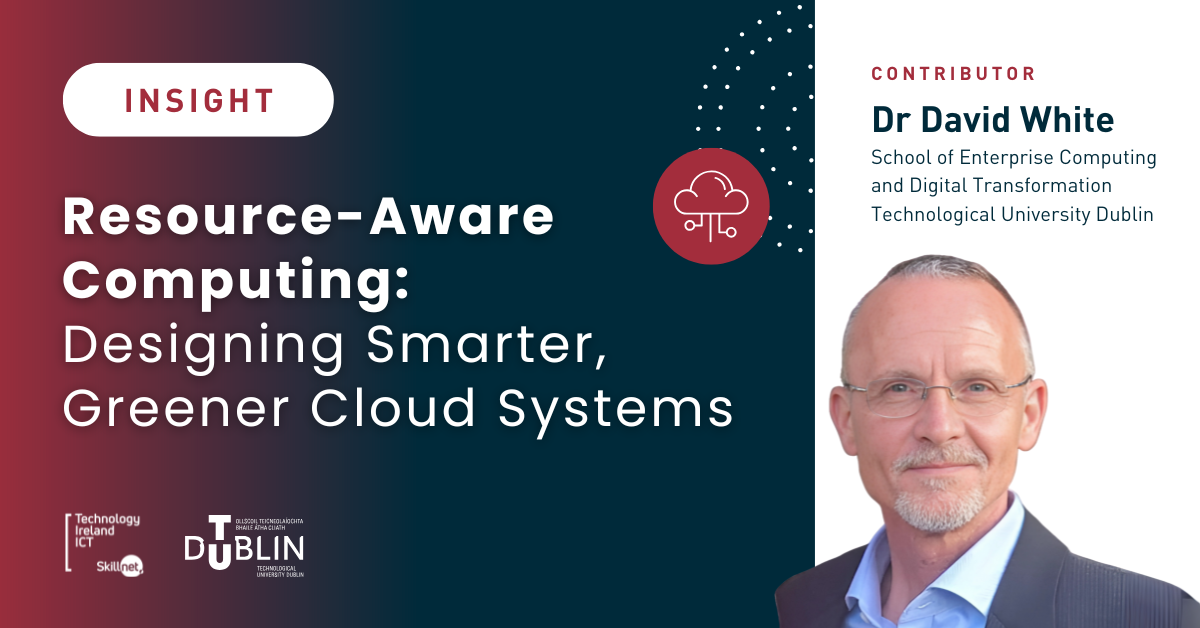
In the rush to deliver faster services, bigger applications, and seamless user experiences, it is easy to forget that every line of code and every virtual machine spins up on real-world hardware consuming real-world energy.
Cloud usage in Private, Public and Hybrid scenarios increase global energy use, and as cloud adoption continues to rise, so too will this energy consumption. This is where resource-aware computing comes in as a strategic competency for anyone building or managing modern private, public & hybrid cloud systems. This short review looks at the key considerations and implications of Resource-Aware Computing and how courses such as the MSc in Sustainable Cloud Computing from TU Dublin and Technology Ireland ICT Skillnet address these new challenges.
What is Resource-Aware Computing?
At its core, resource-aware computing is about designing and running software in ways that make intelligent, efficient use of computational resources – CPU cycles, RAM, network bandwidth, storage, and energy. Instead of provisioning resources based on worst-case scenarios or static assumptions, resource-aware systems monitor usage patterns, workload demands, and environmental constraints in real time, adjusting allocations dynamically to meet performance requirements without waste. Think of it as “driving the cloud with fuel efficiency in mind”.
From Awareness to Action: Why It Matters for Energy Efficiency
The connection between resource awareness and energy efficiency is direct:
- Less idle capacity = less wasted power
- Better workload placement = cooler, more balanced systems
- Right-sizing resources = lower carbon footprint
When applications automatically scale down during low-traffic periods or shift workloads to more energy-efficient regions or hardware, they directly reduce operational energy draw. Multiply that effect across hundreds/thousands of workloads in large scale Data Centers and this can have significant effects. For organisations facing ESG (Environmental, Social, and Governance) reporting requirements, resource-aware approaches don’t just save money – they also contribute to measurable sustainability metrics.
For example, if a workload can run in either a West Coast or East Coast region, a resource-aware system might choose the location where the grid is currently using more renewable energy – effectively lowering the carbon intensity of each request served.
Sustainable Architecture & Resource Awareness
A sustainable architecture means designing the architecture so that it adapts, optimises, and minimises waste over its lifecycle. Resource-aware principles enhance sustainability in several ways, for example:
Workload Placement Optimisation: Intelligent schedulers (such as Kubernetes with energy-aware plugins) can place workloads on nodes that have available capacity, rather than waking up new nodes unnecessarily.
Data Lifecycle Management: Resource-aware storage systems can automatically move infrequently accessed data to cheaper, colder storage tiers – saving cost and power without impacting performance for active datasets.
Energy-Proportional Computing: Designing systems so that energy use scales proportionally with load, avoiding situations where servers draw almost the same power at 10% load as they do at 80% load. Resource-aware Autoscaling takes it further, incorporating multi-metric triggers (e.g., memory pressure, network throughput, and latency together) and factoring in cost per resource unit in real time.
Why Resource-Aware Computing Is a Vital Competency
For cloud professionals, DevOps engineers, and IT decision-makers, resource-aware computing is essential for:
- Economic efficiency: Cloud bills can be cut dramatically by reducing idle or over-provisioned resources
- Regulatory compliance: Many jurisdictions now require reporting on energy usage and carbon emissions
- Resilience: Systems that adapt resource use to real-time conditions are better at handling unexpected demand spikes or hardware failures
- Reputation: Consumers and enterprise clients increasingly prefer services from environmentally responsible providers
Designing a sustainable system in 2025 involves considering efficiency per watt, per euro, and per workload. Examples where this comes into play include:
Google Cloud’s Carbon-Aware Computing
- Google Cloud has implemented carbon-intelligent load shifting, where workloads are dynamically moved to Data Centers in regions with greater availability of renewable energy at that moment. This reduces emissions without compromising performance.
Kubernetes Vertical Pod Autoscaler (VPA) with Observability
- In modern DevOps pipelines, teams use Kubernetes VPA with monitoring tools like Prometheus to right-size pods automatically. Over time, the system learns actual resource usage and adjusts pod requests and limits to avoid both under-provisioning (performance loss) and over-provisioning (waste).
Building the Skills & Qualifications
While some resource-aware practices can be implemented through off-the-shelf cloud features, true mastery requires understanding not just how to configure a tool, but how to design a system that’s efficient by design.
This is where advanced programs like the MSc in Sustainable Cloud Computing make a difference. This course brings together both Public and Private Cloud architectures, DevOps automation, energy efficiency strategies, and sustainability science. Our students learn to:
- Model and measure resource demands
- Integrate environmental data into scaling and deployment decisions
- Apply optimisation techniques across compute, storage, and networking layers
- Design architectures that are both high-performing and low-carbon
Graduates gain the ability to align IT decisions with broader sustainability goals, making them valuable assets to forward-thinking organisations.
Conclusion
Resource-Aware computing asks us to stop treating cloud capacity as limitless and start treating it as a precious, managed resource. For professionals designing modern systems, this means embedding efficiency, adaptability, and environmental responsibility into the architecture itself, not as afterthoughts, but as core design principles.
The payoff? Lower costs, greener footprints, and systems that are ready for the demands of a sustainable future.
In an industry where performance and sustainability increasingly go hand in hand, resource-aware computing is the competency that will set apart leaders. And for those looking to develop that skill set, programs like the MSc in Sustainable Cloud Computing offer a direct, practical path to achieve this.
Power tomorrow’s cloud, responsibly
The 2-year online Master’s in Sustainable Cloud Computing, the first of it’s kind in Ireland, blends cloud architecture, automation, AI-driven data engineering with sustainability principles. It prepares professionals to design resource-aware computing systems that optimise workloads in real time, balancing performance, cost and carbon impact.
Advanced technical cloud architecture learning with deep sustainability insight

